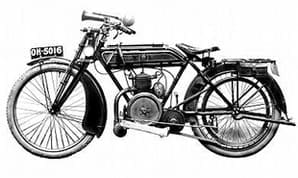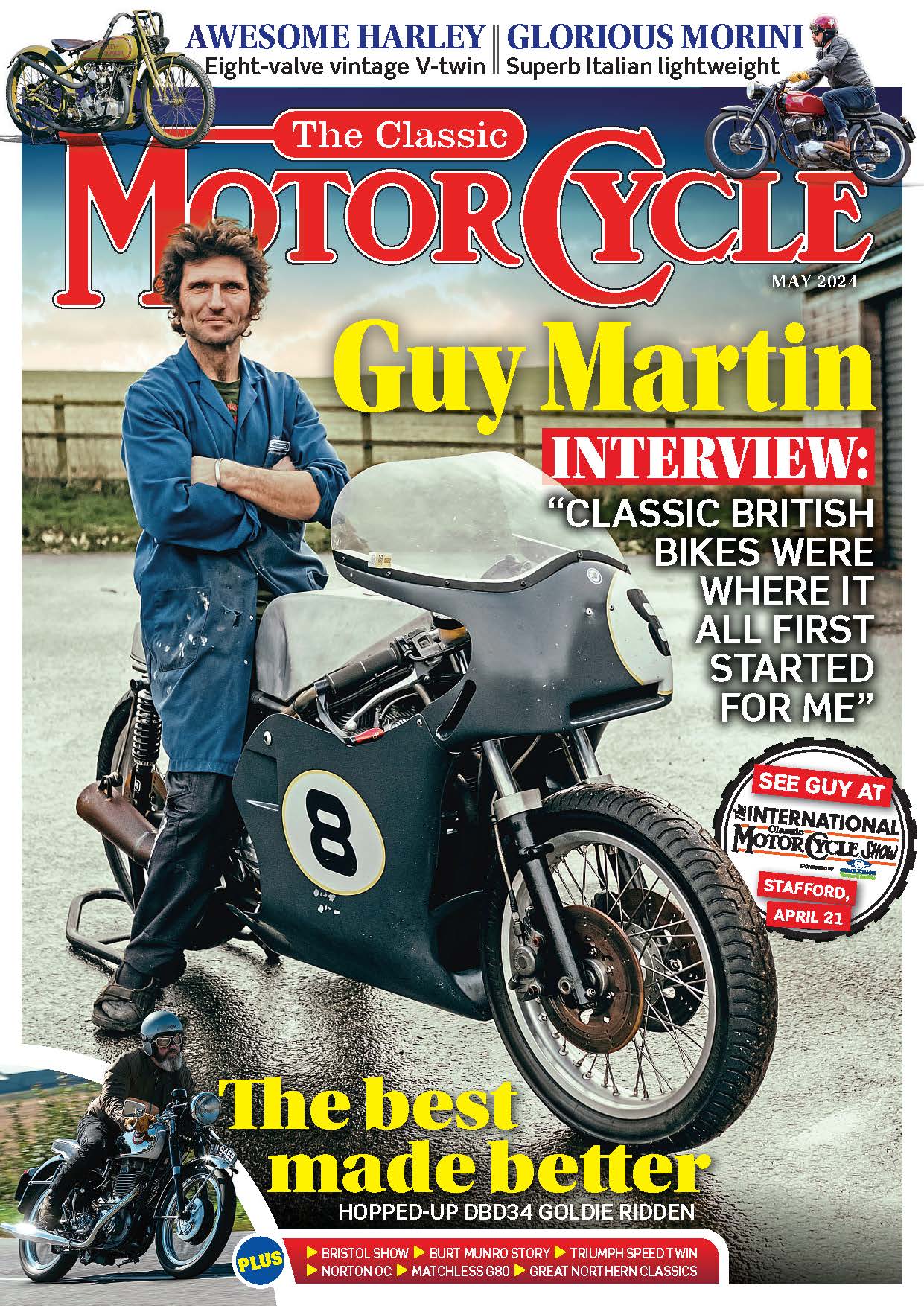
Watney 1922-23 UK
Another small volume maker who assembled, or had assembled, motorcycles using proprietary parts. Engines included 348cc side-valve Blackburne, 293cc side-valve JAP, 269cc Villiers Mk V and 247cc Villiers Mk V1.
Waverley 1921-23 UK
One of literally hundreds of makers and assemblers who tried to make their fortune as motorcycle manufacturers using bought-in components including frame kits, fuel tanks and wheel hubs. Waverley Motors of 137 Lichfield Road, Birmingham launched a four model range using 269cc Peco, possibly Villiers and 348cc side-valve Blackburne engines. Within a year, Albion and Burman gearboxes were dropped in favour of Sturmey Archer units and two of the two-stoke models were dropped in favour of a 499cc Blackburne powered machine aimed at the sidecarist. Sales slowed in 1923 and Waverley production ended.
Enjoy more Classic MotorCycle reading in the monthly magazine.
Click here to subscribe & save.
Wearwell 1901-06 UK
Under the guidance of William Clarke the Wearwell Motor Carriage Company began transport development by fitting two small Butler engines, side by side, to a four wheeled vehicle c1900. The Pountney Street, Wolverhampton firm then began small volume motorcycle production in 1901, fitting a 21⁄2hp Stevens engine within the frame diamond to the front down tube of a heavyweight cycle employing direct drive to the rear wheel.
Members of the Stevens family, including Harry and Joe (senior), who were later with other family members to form AJS, were directly involved with Wearwell's early work.
Using Stevens air cooled engines, Wearwell continued to build motorcycles until 1906 and installed water-cooled Stevens engines to their Motette forecar. After development work the Wearwell was relaunched as the Wolf and by 1914 the company, which had become the Wulfruna Engineering Company Ltd, was listed in trade guides as operating from Brick-Kiln Street, Wolverhampton.
A small number of Wearwell machines survive including a fine exhibit displayed for many years in the Birmingham Museum of Science and Industry. Beware fakes as a number of small Stevens engines, which were also used as industrial units, survive and at least two have been built in recent times into motorcycles using period cycles for the rolling chassis.
Weaver 1922-25 UK
Yet another motorcycle marque from Alfred Wiseman Ltd, Glover Street, Birmingham. Production started using a 152cc (55 x 62mm) four-stroke engine with options of three-speed gearbox or direct drive with cycle-pedalling gear for starting and assistance on hills. Later models were powered by AZA and 147cc single cylinder Villiers two-stroke engines.
Wee McGregor 1922-26 UK
Built by Coventry Bicycles Ltd, Wellington Street, Coventry with design, guidance and sales by two former Hobart employees. Initial 170cc two-stroke models offered with either direct drive or two-speed Albion gearbox were not that dissimilar to 170cc (60 x 60mm) McKenzie built by Hobart for George (Geo) McKenzie of London. For 1924 Wee McGregor continued with their direct drive and two-speed models but engine capacity was increased to 205cc.
Werner 1897-1908 France
Werner, whose Paris addresses variously included 85 Rue Richelieu and 40 avenue de la Grande Armee, were amongst the most influential motorcycle makers from the Pioneer period. Russian emigres and professional journalists Eugene and Michel Werner moved to France to rid themselves of the then oppressive strict Russian publishing legislation. Soon established in Paris they dropped journalism in favour of becoming inventors.
Initial work involved improving current technological equipment including the cinematograph, phonograph and typewriter.
How much, if any, money they made with these projects is unclear although the Werners were well respected in the fledgling cinematograph world. Captivated by the work on pioneer petrol engined vehicles in France during the mid-1890s, the Werners decided to focus on building a working saleable motorcycle having dismissed cars as too crude!
Their first machine in 1896, with rear-mounted engine driving the rear wheel by friction disc and chain, wasn't a success. The following year, the brothers mounted their engine over a cycle's front wheel with drive by belt to create their first production model, The Motocyclette. Displayed at the Salon du Cycle at the Salle Wagram, the new design received a mixed reception. The concept was top heavy making it difficult to balance and prone to side-slip on greasy road surfaces plus the idea of riding with an open burner heating the platinum wire hot-tube ignition in front of the rider wasn't that appealing.
However, British speculative businessman Harry Lawson and his brother in law Thomas Robinson, were impressed even after Robinson crashed, setting himself briefly alight! Lawson negotiated patents for UK production and with the sudden influx of cash the Werners too went from small scale to volume production. After making just 12 machines in 1897 they built 300, then 500 in the following years using a new factory at Levallois-Perret. The Werner sold well in the UK and the concept was copied by Raleigh and in revised form by Royal-Enfield who stuck with the front mounted engine but opted for rear wheel drive.
Although the dangerous hot tube ignition was soon replaced by battery and trembler coil to make the Motocyclette a more practical proposition, Eugene and Michel knew the machine wasn't that easy to ride leading them to a new concept which was to significantly advance motorcycle design.
Rather than use an existing cycle frame the Werner's lengthened the frame moving the pedal crank backwards and replaced the former pedal bracket with the engine, which instantly became a frame stress member. The design of fitting the engine in this way became known as The Werner Position. Suddenly the motorcycle was easier to control with a lower centre of gravity and sideslip, even on slippery horse dung strewn roads, was eliminated. Eugene and Michel patented their new design tying the hands of rival makers until they could find ways round the patent. This delayed the competition giving Freres Werner a sound head start. Production of the new 262cc four-stroke machine leapt to over 1000 motorcycles per year and after discussions with Harry Lawson, a successful English company, Werner Motors Ltd was established.
Larger single cylinder models were built and by 1903 Werner was building over 3000 motorcycles per year. However, in an effort to build their business Eugene and Michel had overstretched themselves both with promotion and new model development including a parallel twin announced for the 1905 season. Their troubled company was bought by British consortium and restructured as Werner Freres Ltd. In turn the brothers gained over £20,000 apiece which they unwisely invested in Russian stock, the value of which then plummeted. It’s claimed by many, the worry of this and the rigors of building their business, undermined the Werners’ health, first Michel died and then Eugene.
Sadly, once the financial consortium had taken over, and with the loss of Michel Werner, the business lost direction. Although odd designs appeared from 1906 they were little more than top dressing like as the installation of the twin cylinder engine in a tricar. Such was progress in motorcycle design during the pioneer period that the firm which from their launch had been responsible for such advanced concepts, were within a couple of years left marketing dated concepts.
Under the guidance of the British consortium, car production began in 1906 and motorcycle production ended in 1908, car manufacture continued until 1914. Despite motorcycle production ending during the pioneer period there is no doubting the Werner's contribution to the motorcycle industry and with estimates of total production ranging from six to 12,000 machines, survival is fair.
Werner-MAG 1928-30 Austria
Limited production of bespoke 498cc ohv singles and 746/996cc inlet over exhaust valve V-twins with MAG engines. Designed by Konstantin Leschan there is no link between this Austrian factory and the French made machines designed by Eugene and Michel Werner.
Weslake Post WWII UK
Born in Exeter in 1897, Harry Weslake was after schooling, apprenticed as an engineer to Willey & Co who did much work for the gas industry, a company of which his father Henry was a director. During WWI Harry enlisted as a cadet with the RFC and spent time (much after hours) developing carburettor designs, some of which his father patented. After work on many forms of throttle control Harry settled on the flat slide concept, which went into production as the Wex (W-eslake EX-eter) Twin Diffuser carburettor after WWI.
During the Twenties Harry Weslake became involved with sponsorship and development for Brooklands entrants, including with Sunbeam's blessing, amateur rider Gordon Cobbold. As a result, Weslake developed an interest in cylinder head development, especially in the field of 'gas flowing'. Among his clients and associates were Bentley, Jaguar (initially SS) and Norton motorcycles. Some years after WWII Weslake established himself in premises at Rye, Sussex and then began trading as Weslake and Co Ltd, Research Engineers.
Much 1950s work focused on car engine development, and especially cylinder head design but motorcycle work included gas flowing cylinder heads for racing AJS, Norton and JAP engines, all in the quest for more power. Weslake developed an interest in pattern making and as a result then had the ability to build complete engines for racing cars plus racing and competition motorcycles. Development work for many firms, including Rickman, continued and eventually Weslake began building production engines in a number of capacities.
During the Seventies in collaboration with John Caffrey, Weslake built first eight-valve 500cc vertical twin cylinder motorcycles called the Vendetta, which was later joined by a 750cc version. In reality, Weslake built engines and developed gearboxes but had little to do with rolling chassis manufacture.
Weslake engines powered many racing, speedway, competition and sprint motorcycles including the awesome doubled engined Hobbit which John Hobbs sprinted to so many records.
Many classic sporting motorcycles on offer today are labelled Weslakes but as can be seen from the preceeding Weslake were seldom involved in building complete machines. However, the Weslake name is often used to imply extreme performance within the classic world, which owners often wish to be associated with.
WFM 1947-c1980/90s Poland
The Warszawska Fabryk Motocycli built a range of 123/147/173cc two-stroke motorcycles, which were steadily updated over the years in their Warsaw factory. In 1957 they launched the 149cc two-stroke Osa M50 scooter with larger than average – for a scooter – 14in wheels hidden under bulbous bodywork.
Whippet 1919-21 UK
One of the better examples from the rash of scooters, which were marketed after WWI, the Whippet had an 180cc ohv single cylinder engine and 16in wheels.
Whippet 1957-59 UK
A cross between a scooter and a moped the Whippet, which is better known as the Dunkley Whippet was powered by a choice of 49, 61 and 64cc ohv single cylinder engines. Note: Another British company built Whippet motorcycles c1903-06 usually with either Aster or FN engines.
White and Poppe 1922-22 UK
Well known proprietary engine maker who also built motorcycles. Famously, Ariel installed White and Poppe engines with widely spaced valves to many solo and sidecar motorcycles either side of WWI. Their engines powered a range of motorcycles, tricars and cyclecars and after WWI they added a two-stroke single cylinder engine to their proprietary engine range.
Motorcycle production began with single cylinder models, later joined by V-twins and in 1906 they unveiled a 500cc parallel twin cylinder powered machine. Although production was limited, a few White and Poppe motorcycles survive including a class 2 (1905-09) single, which has regularly completed the annual Pioneer Run for decades.
Founder Poppe's son Erling, was a partner of P & P (Packman and Poppe), which closed after the early death of his partner Gilmour Packman. Erling then moved to commercial vehicle and bus design before being contracted by BSA for the design work on the post WWII Sunbeam S7. Before volume production started BSA and Erling Poppe parted company.
Whitwood 1934-36 UK
Range of 250-500cc JAP single cylinder powered monocars built by OEC but marketed as the Whitwood-Monocar. In effect a light car on two wheels with outrigger wheels or skids which were lowered at slow speeds and when stopping. Claimed by some to handle and drive better than expected but sales were slow.
Whizzer 1939-c1962 USA
Production began with a friction drive 138cc side-valve four-stroke cycle clip-on attachment. Later Whizzer offered a complete machine comprising a heavy American style cycle with a side-valve engine mounted within the main frame. Drive was a two-stage belt arrangement with the primary belt driving a double pulley jockey wheel which in turn acted as a reduction gear to drive the rear wheel, again by belt. Whizzers offered no rear suspension but initially rocking action front fork, later replaced by a basic undamped telescopic front fork.
Later rolling chassis design was changed with the adoption of a Schwinn loop frame but belt drive remained as did the side-valve engine. Fitted with pedals for easy starting and to assist on hills, the Whizzer was for a decade or so, every American paper delivery boy's dream and carried endless youngsters and the young at heart about their daily business. Some design features, including the pegged crankshaft design, were a bit quirky but until the invasion of Japanese lightweights to the US in the early Sixties the Whizzer sold well.
Wiga 1928-38 (1932) Germany
Small volume maker of 100-500cc motorcycles powered by proprietary engines from Kuchen and JAP. Top models included ohv 500s with Tottenham, London made engines and an ohc Kuchen powered machine with three valve cylinderhead.
In 1932 Wiga production ended and the small firm concentrated on other business but motorcycles weren't forgotten as a prototype 500 with JAP engine and full rear suspension was built in 1938 but further plans were sunk by WWII.
Wilhelmina c1903-15 Holland
Well known pre-WWI importer and dealer who built a range of motorcycles using British and Continental made proprietary engines. From tiny production levels output steadily rose year on year to WWI but didn't restart after the war's end.
Wilier 1962-c1972 Italy
Maker of under 50cc mopeds, ultra lightweight motorcycles and mini-bikes. Odd examples surface at European jumbles for modest prices but like all mini-bikes Wilier offerings are steadily commanding higher and higher prices.
Wilkinson 1903 (1908)-15 UK
World famous for the fine edge of their blades the Wilkinson Sword Company with offices in Pall Mall, London decided to widen their range to include the production of motorcycles. To this end they unveiled a pedal start direct drive model with options of 21⁄4hp or 23⁄4hp Antoine engines mounted in a neat loop frame. With marketing managed by a Chelsea garage, sales were slow and the scheme dropped.
Later in the Edwardian period, young engineer PG Tacchi designed a scouting motorcycle mounted with a Maxim machine gun (made by the Wilkinson Sword Company). The patented (8215/1908) frame boasted full rear suspension by means of the rear wheel mounted to four-quarter elliptic leaf springs, with Chater-Lea leading link front fork steering options comprised conventional motorcycle handlebars or steering wheel and drag link control.
Powered by a V-twin engine a prototype registered H 5029 was offered to the military for appraisal. They didn't order but in the late Edwardian era many military officials still favoured horses.
After further development the 676cc aiv inline four-cylinder Wilkinson TAC (Touring Auto Cycle) was unveiled to the public at the 1909 Stanley Show, London. With new forks patented by Messers Tacchi and Kirschbaum and options of handlebar or steering wheel. The company offered both civilian and military models.
Wilkinson Sword continually developed their motorcycle and the changes can be seen on surviving examples. In late 1911 a new model, the 848cc side-valve TMC (Touring Motor Cycle) with water cooling, increased ground clearance and many other modifications, was displayed at the late season London Show. Changes continued, for example, the show model had Druid front fork but by April 1912 the company had switched to Saxon forks.
During summer 1913 an optional 996cc was on offer for those, especially sidecar drivers, who wanted more power and further detail modifications continued. During the mid Edwardian period, Wilkinson were selling Belgian made De Cosmo cars under their brand and later with design work by Mr Tacchi, began work on developing a light car using the 996cc motorcycle engine. Unfortunately the war clouds were gathering and the famous swordsmith's capacity was once again given over to weapons manufacture.
In March 1914 the manufacture of TMC motorcycles and the light car passed to The Ogston Motor Company Ltd of Acton, London, which was predominantly run and staffed by former Napier employees. The motorcycle, with further development and improvements, continued in production until early 1916 and the car, renamed the Deemster, had its motorcycle derived engine enlarged to 1100cc.
After WWI the former Wilkinson Sword motorcycle factory was turned over to garden tool manufacture while Ogstons continued building Deemster cars until 1924, the last year using Anzani engines rather than their own. To complete the story, legendary car, motorcycle, power-boat and Brooklands star Kaye Don, briefly raced a Deemster car and after WWII founded the Ambassador motorcycle factory at Ascot. ![]()
Advert
 Enjoy more The Classic MotorCycle reading in the monthly magazine. Click here to subscribe.
Enjoy more The Classic MotorCycle reading in the monthly magazine. Click here to subscribe.











